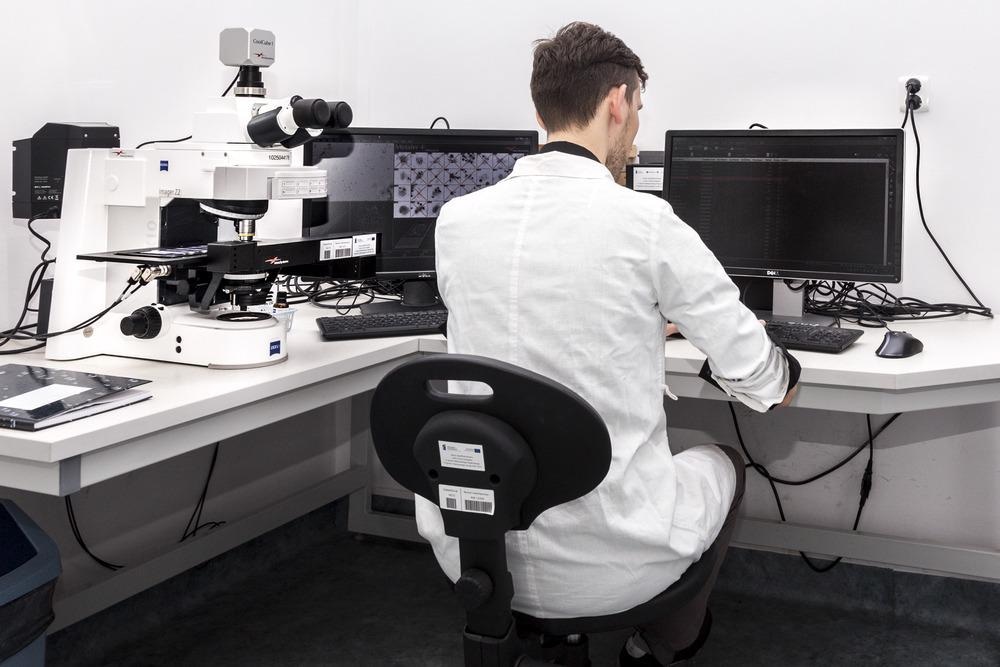A new technique has been developed to help overcome the current limitations of atomic force microscopy (AFM) and make it suitable for biomolecular analysis. Scientists presented localization AFM (LAFM) in a recent paper, novel use of localization image reconstruction algorithms, with data from both conventional AFM and high-speed AFM (HS-AFM). They used the technique to image single amino acids on protein surfaces with an AFM process for the first time.

Image Credit: dominika zara/Shutterstock.com
LAFM was introduced by an international team of interdisciplinary biosciences researchers from the University of Leeds (Leeds, UK), Weiss Cornell Medicine (New York City, USA), and Washington University (St Louis, USA). Their paper was published in the journal Nature in 2021.
Traditional AFM
AFM uses a probe to scan the surface of sample materials and is classed as a type of scanning probe microscopy. In AFM, the probe is made of a very sharp tip connected via a sensitive cantilever to a precise sensor.
At just a few nanometers distance from the sample surface, atomic forces between the probe and surface disturb the probe, causing the cantilever to move on its pivot and the sensor to detect it. Imaging software translates the sensor’s data (in x, y, and z spatial coordinates) into a magnified model.
AFM has been achieved with resolution to sub-nanometer scales, and the technique can magnify over 1,000 times more than the diffraction limit (set by the wavelength of light) allows for optical methods.
AFM is the Leading Method for Surface Topography
Since it was introduced to the scientific community in 1986, AFM has grown in popularity with each passing decade. Now, it is the leading surface topography analysis method, as well as the leading method for investigating functional properties at nanoscale and microscale resolutions.
AFM is a non-destructive method of nanoscale analysis, requiring little sample preparation and a normal laboratory environment. It can also capture nanoscale surface topographies at room temperature and ambient pressure. Compared to cryo-electron microscopy (cryo-EM), which requires rapid cooling of samples before making its analysis, AFM causes minimal disturbance to materials when it scans them.
Current Limitations of AFM
Despite its non-destructive, non-preparation features, AFM is still limited by resolution when it comes to studying biomolecules. These molecules – often with important roles to play in health and medicine, agriculture, food and beverages, and research – present a challenge to traditional AFM.
They are dynamic in nature and feature architectural complexity in the form of nanoscale 3D features that conventional AFM probes struggle to deal with. Biomolecules can also adopt different conformational states multiple times, making them even more difficult to analyze.
AFM’s z-axis resolution (measuring samples’ height or topography) is typically around one angstrom (Å, or a tenth of a nanometer), whereas lateral x and y dimensions are generally around one nanometer. The limitations are based on the geometry of the probe itself as well as the interaction forces between the probe and sample.
Lateral resolution is even lower with softer samples, because of more contact area between the tip and structures of flexible proteins.
These limitations mean that so far, the only biological samples to be reported at the sub-nanometer lateral resolution have been two-dimensional (2D) crystals.
But AFM is still a promising technique for analyzing these particles. As well as being non-destructive and achieving sub-nanometer level resolution, AFM can identify different unlabeled single molecules in an organic material buffer. The fact that all of this could be performed at room temperature and under ambient pressure makes AFM all the more appealing for biomolecular analysis.
New Localization AFM Technique Improves on Lateral Resolution
Recently, new so-called localization microscopy methods have been developed. These include photoactivated localization microscopy (PALM) and stochastic optical reconstruction microscopy (STORM). These techniques have offered a new look at the architecture and macromolecular assemblies of cells.
Localization microscopy works by isolating the source of excited fluorescence signals and pinpointing with high precision over many images. With this sequence of images, a high lateral resolution map can be reconstructed. Localization has broken the diffraction limit of optical microscopy, bringing resolution down from 400 nanometers to around 20 nanometers.
In a new paper, researchers present localization AFM (LAFM). The technique employs localization algorithms to process spatial fluctuations recorded by topographic features, both in AFM and HS-AFM tests.
The approach brings the lateral resolution of AFM down to the angstrom range, in line with its vertical resolution. The method was verified by comparing results with X-ray structures and molecular dynamics simulations.
The researchers resolved single amino acid residues on soft protein surfaces with the new LAFM technique, even in natural and dynamic conditions. They say that their LAFM algorithms can be used in post-acquisition image reconstruction for any AFM dataset.
In the future, faster HS-AFM techniques will enable a greater temporal resolution to accompany the new order of lateral spatial resolution introduced by LAFM.
The researchers behind the LAFM breakthrough expect that this technique will become the standard method used for all AFM imaging.
References and Further Reading
Cao, W. et al. (2021) Massively parallel cantilever-free atomic force microscopy. Nature Communications. https://doi.org/10.1038/s41467-020-20612-3
Geisse, N. A. (2009). AFM and combined optical techniques. Materials Today. https://doi.org/10.1016/S1369-7021(09)70201-9
Heath, G. R. et al. (2021). Localization atomic force microscopy. Nature. https://doi.org/10.1038/s41586-021-03551-x
Disclaimer: The views expressed here are those of the author expressed in their private capacity and do not necessarily represent the views of AZoM.com Limited T/A AZoNetwork the owner and operator of this website. This disclaimer forms part of the Terms and conditions of use of this website.